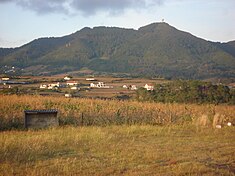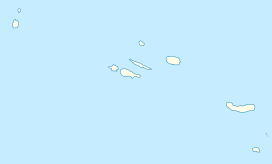Pico Alto (Santa Maria)
| Pico Alto | |
|---|---|

A vista of the Pico Alto sierra that divides the parishes of São Pedro, Santo Espírito and Santa Bárbara
|
|
| Highest point | |
| Elevation | 586.64 m (1,924.7 ft) |
| Prominence | 586.64 m (1,924.7 ft) |
| Parent peak | None - HP Santa Maria |
| Coordinates | 36°58′59.74″N 25°5′26.17″W / 36.9832611°N 25.0906028°WCoordinates: 36°58′59.74″N 25°5′26.17″W / 36.9832611°N 25.0906028°W |
| Geography | |
| Parent range | Mid-Atlantic Ridge |
| Geology | |
| Age of rock | 2-5 Million Years |
| Mountain type | Pyroclastic cone |
| Volcanic arc/belt | Volcanic Arc |
| Climbing | |
| Easiest route | Scramble, Class 2; YDS Grade II |
Pico Alto (literally high/tall peak) is the highest point, 586.64 metres (1,924.7 ft), on the island of Santa Maria, in the Portuguese archipelago of the Azores.
The initial formation of the Facho-Pico Alto Volcanic Complex was a phase of intense volcanism, resulting from submarine eruptions as early as 5 million years ago, resulting in the formation of Pico do Facho and extensive pillow lavas. Remnants of these pillow lavas can be identified 180 metres (590 ft) above sea level, helping to increase the size of the island to roughly its current dimensions.
Following these eruptions, the land receded into the sea, resulting in a period of sub-aerial volcanism that resulted in the great relief in the complex, which is associated with lahars and erosional growth. The Pico Alto complex occurred continuously between 5 and 3 million years ago.
On 5 December 2012, the Secretaria Regional dos Recursos Naturais (Regional Directorate for Natural Resources) announced that they were beginning a reforestation program for Pico Alto; the forest of Santa Maria was considered "more identitical to those original [pre-colonization] forests of the Azores". Using seed from the Forest Service of Nordeste, the operational team of the Nature Park of Santa Maria began planting endemic species of Heather (Vaccinium cylindraceum), Azores Laurel (Laurus azorica) and other plants. This followed a program of eliminating invasive plants species that began in 2011, under the Plano Regional de Controle de Flora Invasora em Áreas Sensíveis program.
The island of Santa Maria was created from successive layers of volcanic materials and marine sediments stratified over the course of a formative period, of which Pico Alto was created between 2 and 5 million years ago. The oldest island in the Azores, many of the original geological structures and volcanic morphology has been totally or partially eroded, dismantled and difficult to detect in the landscape of the island. Pico Alto being the largest structure within the Facho-Pico Alto Volcanic Complex has persisted throughout the island's geological history.
...
Wikipedia

